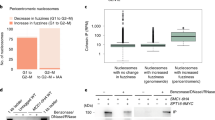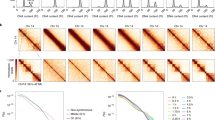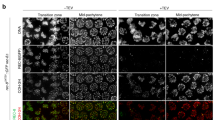Abstract
The reversible condensation of chromosomes during cell division remains a classic problem in cell biology. Condensation requires the condensin complex1 in certain experimental systems2,3,4,5,6,7,8, but not in many others9,10,11,12,13,14,15. Anaphase chromosome segregation almost always fails in condensin-depleted cells, leading to the formation of prominent chromatin bridges and cytokinesis failure4,9,10,11,12,13,14,15,16,17. Here, live-cell analysis of chicken DT40 cells bearing a conditional knockout of condensin subunit SMC2 revealed that condensin-depleted chromosomes abruptly lose their compact architecture during anaphase and form massive chromatin bridges. The compact chromosome structure can be preserved and anaphase chromosome segregation rescued by preventing the targeting subunit Repo-Man from recruiting protein phosphatase 1 (PP1) to chromatin at anaphase onset. This study identifies an activity critical for mitotic chromosome structure that is inactivated by Repo-Man–PP1 during anaphase. This activity, provisionally termed 'regulator of chromosome architecture' (RCA), cooperates with condensin to preserve the characteristic chromosome architecture during mitosis.
This is a preview of subscription content, access via your institution
Access options
Subscribe to this journal
Receive 12 print issues and online access
$209.00 per year
only $17.42 per issue
Buy this article
- Purchase on Springer Link
- Instant access to full article PDF
Prices may be subject to local taxes which are calculated during checkout





Similar content being viewed by others
References
Hirano, T. Condensins: organizing and segregating the genome. Curr. Biol. 15, R265–R275 (2005).
Hirano, T. & Mitchison, T. J. A heterodimeric coiled–coil protein required for mitotic chromosome condensation in vitro. Cell 79, 449–458 (1994).
Hirano, T., Kobayashi, R. & Hirano, M. Condensins, chromosome condensation protein complexes containing XCAP-C, XCAP-E and a Xenopus homolog of the Drosophila Barren protein. Cell 89, 511–521 (1997).
Saka, Y. et al. Fission yeast cut3 and cut14, members of the ubiquitous protein family, are required for chromosome condensation and segregation in mitosis. EMBO J. 13, 4938–4952 (1994).
Strunnikov, A. V., Hogan, E. & Koshland, D. SMC2, a Saccharomyces cerevisiae gene essential for chromosome segregation and condensation defines a subgroup within the SMC-family. Genes Dev. 9, 587–599 (1995).
Sutani, T. et al. Fission yeast condensin complex: essential roles of non-SMC subunits for condensation and Cdc2 phosphorylation of Cut3/SMC4. Genes Dev. 13, 2271–2283 (1999).
Lavoie, B. D. et al. Mitotic chromosome condensation requires Brn1p, the yeast homologue of Barren. Mol. Biol. Cell 11, 1293–1304 (2000).
Aono, N. et al. Cnd2 has dual roles in mitotic condensation and interphase. Nature 417, 197–202 (2002).
Hagstrom, K. A., Holmes, V. F., Cozzarelli, N. R. & Meyer, B. J. C. elegans condensin promotes mitotic chromosome architecture, centromere organization, and sister chromatid segregation during mitosis and meiosis. Genes Dev. 16, 729–742 (2002).
Kaitna, S. et al. The Aurora B kinase AIR-2 regulates kinetochores during mitosis and is required for separation of homologous chromosomes during meiosis. Curr. Biol. 12, 798–812 (2002).
Steffensen, S. et al. A role for Drosophila SMC4 in the resolution of sister chromatids in mitosis. Curr. Biol. 11, 295–307 (2001).
Hudson, D. F., Vagnarelli, P., Gassmann, R. & Earnshaw, W. C. Condensin is required for nonhistone protein assembly and structural integrity of vertebrate mitotic chromosomes. Dev. Cell 5, 323–336 (2003).
Ono, T. et al. Differential contributions of condensin I and condensin II to mitotic chromosome architecture in vertebrate cells. Cell 115, 109–121 (2003).
Hirota, T. et al. Distinct functions of condensin I and II in mitotic chromosome assembly. J. Cell Sci. 117, 6435–45 (2004).
Savvidou, E. et al. Drosophila CAP-D2 is required for condensin complex stability and resolution of sister chromatids. J. Cell Sci. 118, 2529–2543 (2005).
Hirano, T., Funahashi, S., Uemura, T. & Yanagida, M. Isolation and characterization of Schizosaccharomyces pombe cut mutants that block nuclear division but not cytokinesis. EMBO J. 5, 2973–2979 (1986).
Bhalla, N., Biggins, S. & Murray, A. W. Mutation of YCS4, a budding yeast condensin subunit, affects mitotic and nonmitotic chromosome behavior. Mol. Biol. Cell 13, 632–645 (2002).
Coelho, P. A., Queiroz-Machado, J. & Sunkel, C. E. Condensin-dependent localisation of topoisomerase II to an axial chromosomal structure is required for sister chromatid resolution during mitosis. J. Cell Sci. 116, 4763–4776 (2003).
Spence, J. M. et al. Colocalization of centromere activity, proteins and topoisomerase II within a subdomain of the major human X α-satellite array. EMBO J. 21, 5269–5280 (2002).
Belmont, A. S. & Straight, A. F. In vivo visualization of chromosomes using lac operator-repressor binding. Trends Cell Biol. 8, 121–124 (1998).
Fukagawa, T. et al. CENP-H, a constitutive centromere component, is required for centromere targeting of CENP-C in vertebrate cells. EMBO J. 20, 4603–4617 (2001).
Oliveira, R. A., Coelho, P. A. & Sunkel, C. E. The condensin I subunit Barren/CAP-H is essential for the structural integrity of centromeric heterochromatin during mitosis. Mol. Cell. Biol. 25, 8971–8984 (2005).
Gerlich, D. et al. Condensin I stabilizes chromosomes mechanically through a dynamic interaction in live cells. Curr. Biol. 16, 333–344 (2006).
Parry, D. H. & O'Farrell, P. H. The schedule of destruction of three mitotic cyclins can dictate the timing of events during exit from mitosis. Curr. Biol. 11, 671–83 (2001).
Meijer, L. et al. Biochemical and cellular effects of roscovitine, a potent and selective inhibitor of the cyclin-dependent kinases cdc2, cdk2 and cdk5. Eur. J. Biochem. 243, 527–536 (1997).
Trinkle-Mulcahy, L. et al. Repo-Man recruits PP1K to chromatin and is essential for cell viability. J. Cell Biol. 172, 679–692 (2006).
Saitoh, N., Goldberg, I., Wood, E. & Earnshaw, W. C. ScII: an abundant chromosome scaffold protein is a member of a family of putative ATPases with an unusual predicted tertiary structure. J. Cell Biol. 127, 303–318 (1994).
Eckley, D. M. et al. Chromosomal proteins and cytokinesis: patterns of cleavage furrow formation and inner centromere protein positioning in mitotic heterokaryons and mid-anaphase cells. J. Cell Biol. 136, 1169–1183 (1997).
Earnshaw, W. C., Ratrie, H. & Stetten, G. Visualization of centromere proteins CENP-B and CENP-C on a stable dicentric chromosome in cytological spreads. Chromosoma 98, 1–12 (1989).
Adams, R. R., Maiato, H., Earnshaw, W. C. & Carmena, M. Essential roles of Drosophila inner centromere protein (INCENP) and Aurora-B in histone H3 phosphorylation, metaphase chromosome alignment, kinetochore disjunction, and chromosome segregation. J. Cell Biol. 153, 865–880 (2001).
Acknowledgements
We thank L. Meijer for the gift of a panel of Cdk inhibitors, including roscovitine; A. Belmont for the gift of the Lac O/Lac I–GFP plasmids; T. Fukagawa for the gift of the CENP-H–GFP targeting construct; E. Nigg for the gift of anti-chicken cyclin B2; R. Tsien for the gift of mCherry; F. Kasai and M. Ferguson-Smith for the chicken Z-chromosome paint; J. Boudeau and D. Alessi for help with the CDK1 assays; and R. Allshire, M. Heck and N. Cobbe for comments on the manuscript. This work is supported by The Wellcome Trust (P.V., A.L. and W.C.E.), The Caledonian Research Foundation (D.H.) and Cancer Research-UK (J.M.S and C.J.F). W.C.E. and A.I.L. are Principal Research Fellows of The Wellcome Trust.
Author information
Authors and Affiliations
Contributions
P.V., D.H., L.T.-M., F.L. and J.M.S. performed the experiments, which were planned by P.V., C.J.F., A.I.L. and W.C.E. The manuscript was written by P.V. and W.C.E. with contributions from all other auhors.
Corresponding author
Ethics declarations
Competing interests
The authors declare no competing financial interests.
Supplementary information
Supplementary Information
Supplementary figures S1, S2, S3, S4 and Supplementary movie legends. (PDF 993 kb)
Rights and permissions
About this article
Cite this article
Vagnarelli, P., Hudson, D., Ribeiro, S. et al. Condensin and Repo-Man–PP1 co-operate in the regulation of chromosome architecture during mitosis. Nat Cell Biol 8, 1133–1142 (2006). https://doi.org/10.1038/ncb1475
Received:
Accepted:
Published:
Issue Date:
DOI: https://doi.org/10.1038/ncb1475
This article is cited by
-
Membrane and organelle dynamics during cell division
Nature Reviews Molecular Cell Biology (2020)
-
PRMT6-mediated H3R2me2a guides Aurora B to chromosome arms for proper chromosome segregation
Nature Communications (2020)
-
Condensin controls mitotic chromosome stiffness and stability without forming a structurally contiguous scaffold
Chromosome Research (2018)
-
Architectural alterations of the fission yeast genome during the cell cycle
Nature Structural & Molecular Biology (2017)
-
Repo-Man/PP1 regulates heterochromatin formation in interphase
Nature Communications (2017)



